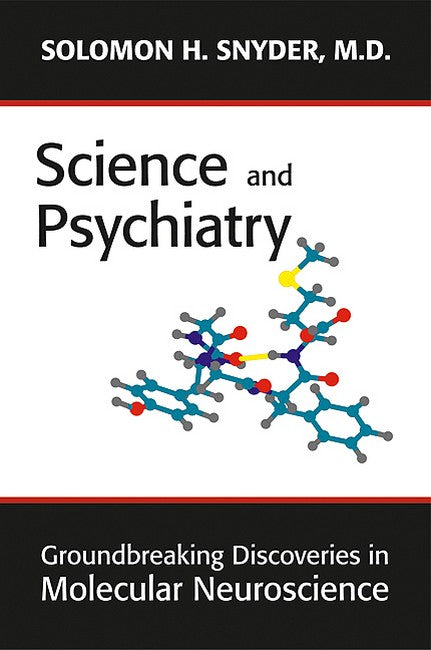About the AuthorForewordIntroductionPart I: DISCOVERY AND CHARACTERIZATION OF THE OPIATE RECEPTOR- Radioligand Binding Methodologies: New Inventions, New DirectionsChapter 1. Opiate Receptor- Demonstration in Nervous TissueChapter 2. Opiate Agonists and Antagonists Discriminated by Receptor Binding in BrainChapter 3. Historical Review- Opioid ReceptorsPart II: CHARACTERIZATION OF THE ENKEPHALINS- The Discovery of Endogenous Opiates and Their Receptors: A Snyderian Saga of Skill and JudgmentChapter 4. Opiate Receptor in Normal and Drug Altered Brain FunctionChapter 5. Morphine-Like Peptides in Mammalian Brain- Isolation, Structure Elucidation, and Interactions With the Opiate ReceptorChapter 6. Opioid Peptide Enkephalin- Immunohistochemical Mapping in Rat Central Nervous SystemPart III: DOPAMINE RECEPTORS AND INFLUENCES OF NEUROLEPTICS- Dopamine Receptor Binding and Its TherapeuticsChapter 7. Dopamine Receptor Binding Predicts Clinical and Pharmacological Potencies of Antischizophrenic DrugsChapter 8. Antischizophrenic Drugs- Chronic Treatment Elevates Dopamine Receptor Binding in BrainChapter 9. Dopamine Receptors, Neuroleptics, and SchizophreniaPart IV: DRUG EFFECTS EXPLAINED AS ACTIONS ON NEUROTRANSMITTER RECEPTORS- Perspectives on Simplicity and DiscoveryChapter 10. Antischizophrenic Drugs and Brain Cholinergic Receptors- Affinity for Muscarinic Sites Predicts Extrapyramidal EffectsChapter 11. Tricyclic Antidepressants- Therapeutic Properties and Affinity for -Noradrenergic Receptor Binding Sites in the BrainPart V: DRUG ACTIONS AND SEROTONIN RECEPTOR SUBTYPES- Clinical Data Stimulation of Basic Research: The Far-Reaching ClinicalSignificance of Serotonin Receptor Subtype IdentificationChapter 12. Long-Term Antidepressant Treatment Decreases Spiroperidol-Labeled Serotonin Receptor BindingChapter 13. Two Distinct Central Serotonin Receptors With Different Physiological FunctionsPart VI: INOSITOL PHOSPHATES AND ACTIONS OF LITHIUM- Lithium, Second Messengers, and Downstream EffectsChapter 14. Lithium Blocks a Phosphoinositide-Mediated Cholinergic Response in Hippocampal SlicesChapter 15. Solubilization, Purification, and Characterization of an Inositol Trisphosphate ReceptorChapter 16. Second Messenger Systems and Psychoactive Drug Action- Focus on the Phosphoinositide System and LithiumChapter 17. Purified Inositol 1,4,5-Trisphosphate Receptor Mediates Calcium Flux in Reconstituted Lipid VesiclesPart VII: NITRIC OXIDE AS A NEUROTRANSMITTER- Just Say "Yes": Snyder's Approach to the Difficult Problem of NOChapter 18. Nitric Oxide Mediates Glutamate-Linked Enhancement of cGMP Levels in the CerebellumChapter 19. Cloned and Expressed Nitric Oxide Synthase Structurally Resembles Cytochrome P-450 ReductaseChapter 20. Behavioral Abnormalities in Male Mice Lacking Neuronal Nitric Oxide SynthasePart VIII: D-AMINO ACIDS AS NEUROTRANSMITTERS- Disruptive Science: Incongruent Findings Lead to Novel Insights Into How the Brain WorksChapter 21. D-Aspartate Localizations Imply Neuronal and Neuroendocrine RolesChapter 22. Serine Racemase- A Glial Enzyme Synthesizing D-Serine to Regulate Glutamate-N-Methyl-D-Aspartate NeurotransmissionChapter 23. Serine Racemase- Activation by Glutamate Neurotransmission via Glutamate Receptor Interacting Protein and Mediation of Neuronal MigrationPart IX: NEURAL MESSENGERS OF CELL LIFE AND DEATH- Beyond NeurotransmittersChapter 24. Cytochrome c Binds to Inositol 1,4,5-Trisphosphate Receptors, Amplifying Calcium-Dependent ApoptosisChapter 25. Bilirubin Benefits: Cellular Protection by a Biliverdin Reductase Antioxidant CycleChapter 26. S-Nitrosylated GAPDH Initiates Apoptotic Cell Death by Nuclear Translocation Following Siah1 BindingPart X: WHAT MAKES FOR CREATIVE DISCOVERY IN SCIENCE?- What Creates Creative Science and Scientists?Chapter 27. The Audacity Principle in ScienceIndex

